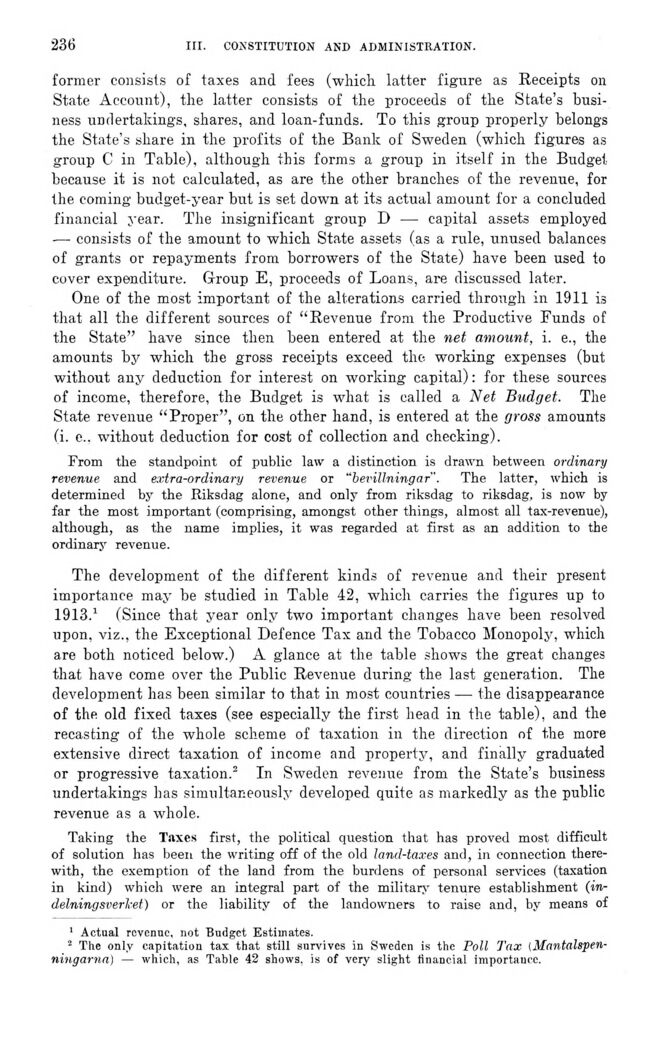
Full resolution (JPEG) - On this page / på denna sida - III. Constitution and Administration. Introd. by E. Hildebrand - 2. State Administration. By E. Söderberg - State Finances. By Eli F. Heckscher

<< prev. page << föreg. sida << >> nästa sida >> next page >>
Below is the raw OCR text
from the above scanned image.
Do you see an error? Proofread the page now!
Här nedan syns maskintolkade texten från faksimilbilden ovan.
Ser du något fel? Korrekturläs sidan nu!
This page has never been proofread. / Denna sida har aldrig korrekturlästs.
■2-20
III. CONSTITUTION AND ADMINISTRATION.
former consists of taxes and fees (which latter figure as Receipts on
State Account), the latter consists of the proceeds of the State’s
business undertakings, shares, and loan-funds. To this group properly belongs
the State’s share in the profits of the Bank of Sweden (which figures as
group C in Table), although this forms a group in itself in the Budget
because it is not calculated, as are the other branches of the revenue, for
the coming budget-year but is set down at its actual amount for a concluded
financial year. The insignificant group D — capital assets employed
— consists of the amount to which State assets (as a rule, unused balances
of grants or repayments from borrowers of the State) have been used to
cover expenditure. G-roup E, proceeds of Loans, are discussed later.
One of the most important of the alterations carried through in 1911 is
that all the different sources of "Revenue from the Productive Funds of
the State" have since then been entered at the net amount, i. e., the
amounts by which the gross receipts exceed the working expenses (but
without any deduction for interest on working capital): for these sources
of income, therefore, the Budget is what is called a Net Budget. The
State revenue "Proper", on the other hand, is entered at the gross amounts
fi. e.. without deduction for cost of collection and checking).
From the standpoint of public law a distinction is drawn between ordinary
revenue and extra-ordinary revenue or "bevillningar". The latter, which is
determined by the Riksdag alone, and only from riksdag to riksdag, is now by
far the most important (comprising, amongst other things, almost all tax-revenue),
although, as the name implies, it was regarded at first as an addition to the
ordinary revenue.
The development of the different kinds of revenue and their present
importance may be studied in Table 42, which carries the figures up to
1913.1 (Since that year only two important changes have been resolved
upon, viz., the Exceptional Defence Tax and the Tobacco Monopoly, which
are both noticed below.) A glance at the table shows the great changes
that have come over the Public Revenue during the last generation. The
development has been similar to that in most countries — the disappearance
of the old fixed taxes (see especially the first head in the table), and the
recasting of the whole scheme of taxation in the direction of the more
extensive direct taxation of income and property, and finally graduated
or progressive taxation.2 In Sweden revenue from the State’s business
undertakings has simultaneously developed quite as markedly as the public
revenue as a whole.
Taking the Taxes first, the political question that has proved most difficult
of solution has been the writing off of the old land-taxes and, in connection
therewith, the exemption of the land from the burdens of personal services (taxation
in kind) which were an integral part of the military tenure establishment
(indelningsverket) or the liability of the landowners to raise and, by means of
1 Actual revenue, not Budget Estimates.
2 The only capitation tax that still survives in Sweden is the Poll Tax
{Mantalspenningarna) — which, as Table 42 shows, is of very slight financial importance.
<< prev. page << föreg. sida << >> nästa sida >> next page >>